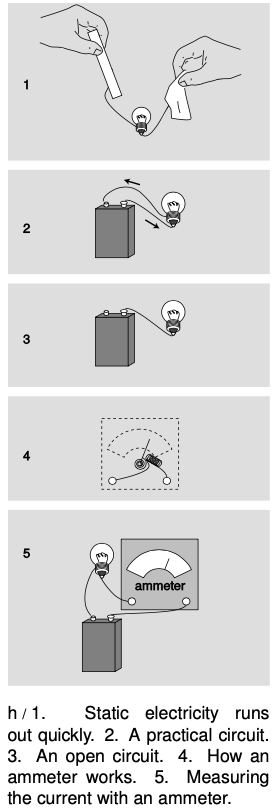LM 21.4 Circuits
Tags | |
UUID | 1e8788bb-f145-11e9-8682-bc764e2038f2 |
21.4 Circuits by Benjamin Crowell, Light and Matter licensed under the Creative Commons Attribution-ShareAlike license.
21.4 Circuits
How can we put electric currents to work? The only method of controlling electric charge we have studied so far is to charge different substances, e.g., rubber and fur, by rubbing them against each other. Figure h/1 shows an attempt to use this technique to light a lightbulb. This method is unsatisfactory. True, current will flow through the bulb, since electrons can move through metal wires, and the excess electrons on the rubber rod will therefore come through the wires and bulb due to the attraction of the positively charged fur and the repulsion of the other electrons. The problem is that after a zillionth of a second of current, the rod and fur will both have run out of charge. No more current will flow, and the lightbulb will go out.
Figure h/2 shows a setup that works. The battery pushes charge through the circuit, and recycles it over and over again. (We will have more to say later in this chapter about how batteries work.) This is called a complete circuit. Today,  the electrical use of the word “circuit” is the only one that springs to mind for most people, but the original meaning was to travel around and make a round trip, as when a circuit court judge would ride around the boondocks, dispensing justice in each town on a certain date.
the electrical use of the word “circuit” is the only one that springs to mind for most people, but the original meaning was to travel around and make a round trip, as when a circuit court judge would ride around the boondocks, dispensing justice in each town on a certain date.
Note that an example like h/3 does not work. The wire will quickly begin acquiring a net charge, because it has no way to get rid of the charge flowing into it. The repulsion of this charge will make it more and more difficult to send any more charge in, and soon the electrical forces exerted by the battery will be canceled out completely. The whole process would be over so quickly that the filament would not even have enough time to get hot and glow. This is known as an open circuit. Exactly the same thing would happen if the complete circuit of figure h/2 was cut somewhere with a pair of scissors, and in fact that is essentially how an ordinary light switch works: by opening up a gap in the circuit.
The definition of electric current we have developed has the great virtue that it is easy to measure. In practical electrical work, one almost always measures current, not charge. The instrument used to measure current is called an ammeter. A simplified ammeter, h/4, simply consists of a coiled-wire magnet whose force twists an iron needle against the resistance of a spring. The greater the current, the greater the force. Although the construction of ammeters may differ, their use is always the same. We break into the path of the electric current and interpose the meter like a tollbooth on a road, h/5. There is still a complete circuit, and as far as the battery and bulb are concerned, the ammeter is just another segment of wire.
Does it matter where in the circuit we place the ammeter? Could we, for instance, have put it in the left side of the circuit instead of the right? Conservation of charge tells us that this can make no difference. Charge is not destroyed or “used up” by the lightbulb, so we will get the same current reading on either side of it. What is “used up” is energy stored in the battery, which is being converted into heat and light energy.
21.4 Circuits by Benjamin Crowell, Light and Matter licensed under the Creative Commons Attribution-ShareAlike license.
Calculators and Collections
- Comments
- Attachments
- Stats
No comments |
